
February is shoulder season for travel to Tanzania, so this month offers a comfortable mix of thinner crowds, lower prices, and great sights and activities. The weather is generally hot, and although there’s a chance of rain, this is more common at night. From seeing baby wildebeest in the parks of the north to blooming orchids in those of the south, beach vacations to mountain climbing, there are many good reasons to travel to Tanzania in February.
Tanzania in February: A Comprehensive Travel Guide
The allure of Tanzania is undeniable, a land of vibrant culture, breathtaking landscapes, and unparalleled wildlife encounters. February presents a unique window of opportunity to explore this East African gem, offering a balance of pleasant weather, manageable crowds, and the chance to witness remarkable natural phenomena. Let’s delve into the specifics of traveling to Tanzania in February, covering everything from the climate to the unmissable events.
Weather
Tanzania boasts a tropical climate, ensuring relatively consistent temperatures throughout the year. However, it’s essential to consider the variations in altitude and rainfall, which can significantly impact your experience. Generally, temperatures range from a comfortable 77°F to 86°F (25°C to 30°C) in the lowlands and along the coast. As you ascend into the highlands, expect a cooler climate, with temperatures hovering around 59°F to 68°F (15°C to 20°C). February falls within a period that is often relatively dry. It’s nestled between the short and long rainy seasons, making it a favorable time to visit. Nevertheless, it’s wise to prepare for the possibility of rain, which can occur in various regions, particularly during the nighttime hours. The period spanning from November to March is commonly referred to as the “green season,” when the landscapes flourish, and the air is crisp and clean. This can make your vacation even more memorable.
Crowds & Costs
February sits comfortably in the shoulder season for travel in Tanzania. This means you can anticipate sharing your safari adventures and beach retreats with other travelers, but the crowds will be significantly less dense compared to the peak season, which stretches from June to October. Unlike the off-season, when some establishments may temporarily close, you’ll find that accommodations and restaurants are generally open and ready to welcome visitors in February. Moreover, this period can unlock opportunities for favorable deals on safari accommodations, activities, and even beach resorts. Savvy travelers can potentially snag some bargains, making their Tanzanian escapade even more budget-friendly.
Where to Go
For those drawn to Tanzania for its world-renowned safaris, February is an excellent time to concentrate your explorations in the northern parks. This month coincides with the remarkable wildebeest calving season, a spectacle of nature that unfolds on the vast Ndutu Plains, within the protected Ngorongoro Conservation Area, and across the southern expanses of the legendary Serengeti National Park. Witnessing the birth of a wildebeest calf and its initial, tentative steps encapsulates the very essence of the circle of life, a sight that will leave an indelible mark on your memory.
Venture to the opposite end of the country, and you’ll discover the captivating Kitulo National Park in southern Tanzania, a destination that shines in February. Established in 2005, this park, nestled within the southern highlands, was created primarily to safeguard the region’s stunning orchids. During the months of November through April, these orchids, alongside a symphony of other wildflowers, burst into vibrant bloom, transforming the landscape into a floral paradise. Visitors have the unique opportunity to observe some of the 45 terrestrial orchid species that thrive within this botanical reserve, the only one of its kind in tropical Africa.
What to Do
If conquering iconic peaks is on your bucket list, Tanzania offers unparalleled opportunities. Consider the challenge of ascending Mount Kilimanjaro (19,340 ft/5,895 m), the undisputed king of African mountains. While Kilimanjaro is often referred to as a “walk-up” mountain, as it doesn’t demand technical climbing expertise, the high altitude can present a significant challenge. For a compelling alternative, consider scaling Mount Meru, located just southwest of Kilimanjaro. As the second-highest mountain in Tanzania, standing tall at 14,967 feet (4,562 m), Meru offers a rewarding climb. Being significantly shorter than Kilimanjaro, altitude-related issues may pose a lesser risk. A trek up Meru promises not only breathtaking panoramas of Tanzania but also the chance to encounter wildlife at lower altitudes and traverse diverse vegetation and terrain.
Regardless of which mountain you choose to conquer, remember that mountain climbing in Tanzania is safest and most enjoyable under dry weather conditions, and February fits the bill perfectly. While temperatures at higher elevations will undoubtedly be cold, February is also one of the warmer months of the year, rendering it an ideal time to attempt a summit of either Kilimanjaro or Meru.
Events in February
Sauti za Busara, Zanzibar: Immerse yourself in the rhythms of Africa at this vibrant music festival, which showcases a diverse array of musicians and singers from across the continent, as well as talents from Europe and beyond.
Kilimanjaro Marathon, Moshi: This popular running event, sometimes held in early March, welcomes amateur runners to test their endurance and experience the stunning scenery around Mount Kilimanjaro. Don’t expect to see professional runners here, as the focus is on fun and participation.
There’s so much to see and do in Tanzania! Whether it’s the call of the wild or the draw of history, Tanzania offers it all. With careful planning, your trip can be unforgettable.
B-2568

